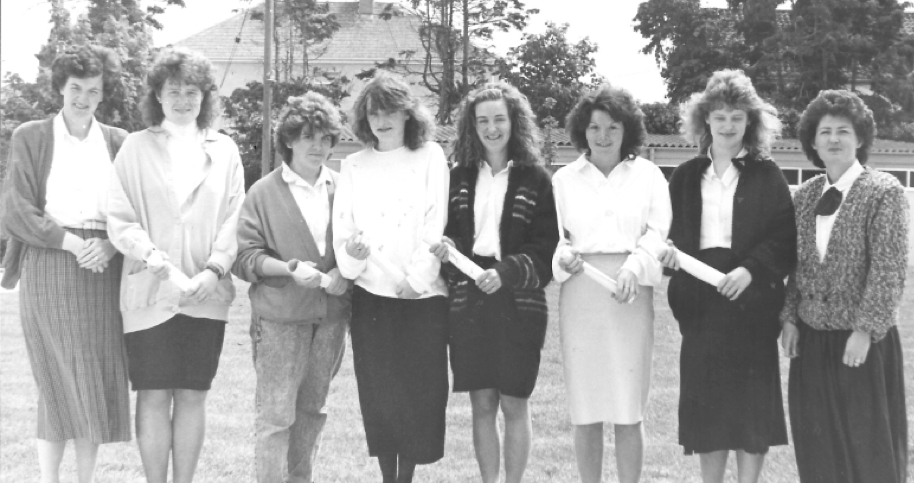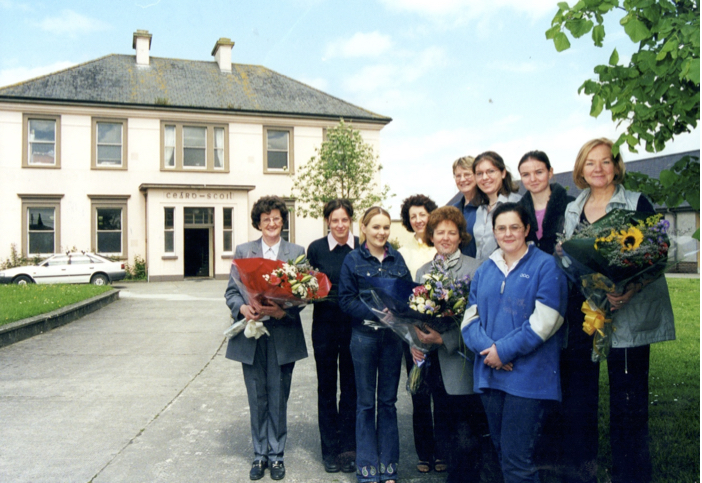Origins and History of the Commerce Class
by Patricia Curtin and Claire Conway
The school opened in 1934, however, the earliest record we have of the commerce class is from Irene Ryan’s (R.I.P.) account which she wrote on the 50th anniversary of the school.
She described a school with 4 classrooms, one each for Domestic Economy, Engineering and Cabinet Making. The last room was shared between Commerce, Science and General Subjects. Irene reported a conversation with a Department official when she was told that it was not government policy to encourage Commerce in rural schools.
With the support of the headmaster Mr. O’Connell, a special timetable was arranged for the class to start at midday and finish at 6pm. This remained in operation until 1955. Equipment was very limited, having less than 6 typewriters for a class of between 40 and 50 students.
Government policy changed and the Group Certificate was introduced in 1941, including two commerce orientated subjects, the Secretarial Group and the Commerce General Group.
The latter was open to 1st and 2nd years, who now had book-keeping and business methods incorporated in their courses. There were other Single Subject examinations which could be taken at Elementary, Intermediate and Advanced Stage.
The standard of these exams was very high.
Students who took Advanced Stage and achieved a 1st class honour were eligible for entry into part-time teaching in any Vocational School. Good results in either system of examinations were instrumental in getting students into the many and varied posts for which they applied through the years and which included local clerical work, Local Government, Civil Service, Bank, Electricity Supply Board, Aer Lingus, American Embassy, Radio Éireann, Bunratty Hostess, Hotel Receptionists etc.
In 1955, Commerce was given a department of its own in the main building which made room for a second teacher, Mr s. Lyons. Equipment also increased gradually during Irene’s time.
There were over 20 typewriters, an electric typewriter, an electric duplicator, a dictaphone, a photocopier (manual), a small adding machine and two filing cabinets. Irene acknowledged the support of Mr. Moran, Mr. Cullinan, Mr. Rushe, Mr. Duggan and Mr. Kelly in securing this equipment.
Irene contributed greatly to the cultural development of both the school and the local community. Debates both class and inter-school, were an integral part of the course at the time. The students also participated in drama and performed plays in places such as the Carnegie Library, St. Ita’s Hospital and Latchford’s Cinema.
Commerce students contributed to articles for the school magazine which was stencilled and duplicated by the class. She was a regular contributor to the Monthly Observer. In 1964 e.g. she contributed very informative articles on Books, Theatre and Film. In them she discussed topics such as Pantomime, Shakespeare, Drama Festivals, The Abbey Theatre and the Pioneers of the National Theatre. Pádraig Collery (R.I.P.) became principal in 1972 and Irene retired in 1973.
Also Muriel Thomas was appointed whole-time physical education teacher to the school. Patricia Curtin joined the teaching staff of the Vocational School to replace Irene in September 1973. Almost all her teaching hours were with the Secretarial/ Commerce Class. The Leaving Certificate was introduced in the school in 1974, with students sitting the Business Organisation exam in 1976.
Seán Rushe was C.E.O. at this time.
Claire Conway joined the staff in 1977 and shared the teaching of the Business and Secretarial subjects. Accounting was introduced as a Leaving Cert subject in the late 70͛s. Mary Conway and Sylvia Nagle (R.I.P.) taught Business Subjects for a time during the 70͛s and Mary Relihan in the early 80’s.
Claire Conway V.T.P co-ordinator and Patricia Curtin pictured at the presentation of Word Processing certificates to Geraldine Campbell, Margaret O’Connor, Mary O’Colbert, Bríd King, Brenda O’Grady and Elaine O’Connor. Many of the photos for school promotions were taken by Michael C. Berkery (photographer).
(image 0139)
The secretarial class was well attended and records from 1984 show that 362 students enrolled in the course from Sept 73-Sept 83 inclusive. The entry requirement in the early 70s was Intermediate Certificate, and at a later date the Leaving Certificate was required. Mature students were always welcome and flexible arrangements were put in place for them.
Computers were becoming accessible and a number of Commodore 64 computers were introduced to the school in the very early eighties. These were very basic computers. It was necessary to type in an exact command for every function. Forgetting a comma meant that the computer wouldn͛t start!
We attended computer training classes facilitated by Dick Boyce (R.I.P.) in Tarbert and later by Michael Fitzgerald in the Education Centre in Kilfinane. This training continued throughout the eighties and beyond, to keep abreast of all the modern technological advances. Seán Burke was C.E.O. by now.
Typewriting (word processing) was now done on computer which was physically less tiring than a manual typewriter. This allowed students to correct and save their work before printing. This was an enormous advantage, particularly when typing legal documents as correction fluid could not be used.
It also meant that a previously saved document could be used as a template for the next similar document rather than starting from scratch. Cutting a stencil for use on a duplicator was examined as part of Advanced Typing up to the 80͛s.
This was very time-consuming and a messy task, as in order to create copies, the ink was forced through the holes in the stencil which was fastened on to the duplicator drum. This was replaced by the photocopier which produced instant copies of very high quality at the press of a button.
Celebrating Commercial Certificates were Karen Hurley, Caroline O’Keefe, Louise Sparling, Mary Kelly, Veronica Copse and Martina Lane.
(image 0140)
In 1986 when attending a course on Information Technology in Thomond College, we visited Wang and witnessed for the 1st time the sending of a fax to their head office in America which we found truly amazing. Fax machines became popular in offices and the students were trained in their use.
From the late 70͛s/early 80͛s our students went on a two week work experience placement in local offices at Easter time. This was not a compulsory part of the course at the time. However, the principal, Martin McNamara (R.I.P.) recognised its benefits and supported the initiative. This later became a mandatory module by The National Council for Vocational Awards (NCVA) and The Further Education and Training Council (FETAC).
The students gained valuable experience in the work place and the opportunity to apply the skills they acquired during the year. We were very lucky that local employers facilitated the work experience placements and that there were local opportunities for employment. In some cases the student was fortunate to secure a job in the office if a vacancy arose.
At this time the Group Certificate Curriculum did not reflect the changes in business practice and technology. For this reason, the school arranged to have the course accredited by RSA (an English examining body). This was for a few years in the early 90͛s.
This required the development of two large portfolios of work incorporating all the subjects. Having a portfolio of evidence was a huge change and challenge compared with the traditional examinations. There were still formal examinations in practical skills such as Typewriting, Word-processing etc.
By now Windows 95 was available. This was a great development as there was now an icon (short cut) for various tasks such as opening a programme, saving and printing etc. This was more user-friendly.
June 1998: Richard Barry Deputy Principal presents NCVA certificates to Marie O’Keeffe, Susan Byrne and Michelle O’Mahony who graduated from the Business and Secretarial Course.
(image 0141)
June 1998: Paula O’Brien, Geraldine Lane, Tracey Sheehan, Letitia Harnett, and Ester McCoy, Business and Secretarial students at the graduation and presentation of NCVA certificates.
(image 0142)
The Secretarial Class receiving their certificates in Word Processing with teachers Claire Conway and Patricia Curtin.
(image 0143)
By the mid 90s the Department of Education had developed a new Business Administration Course (accredited by NCVA) to replace the Group Cert. The NCVA developed its assessment system with reference to international theory and best practice.
These modules incorporated all the new information technology skills including word processing, databases, spreadsheets and graphics. Eileen Flynn-O’Sullivan taught the Communications module. Methods of Assessment were Project Work/Assignments and formal Examinations.
At this stage, students were learning about the internet and email, which they found very interesting and exciting. A new module was developed to formalise the teaching and certification of this. Richard Barry was principal at this time.
Claire Conway VPT co-ordinator, Caroline O’Keefe and hair-dressing instructor Mary White.
(image 0144)
Martin McNamara, Principal, pictured with Noreen Nelligan, Siobhán Harnett, Angela Keane, Elizabeth O’Sullivan, Priscilla Cronin, Joanne McNamara and Patricia Kelly in 1999 at the presentation of their Business Studies Level 2 Certificates. The course combined a mix of hands-on training, academic learning and work placement. It also offered a route into 3rd level studies independent of Leaving Cert Points.
(image 0145)
May 2000. NCVA level two students at Ceard Scoil Newcastle West; Caroline Hayes, Mairead Ahern, Aine McCoy, Audrey Carroll, Joan Phillips, Emer O’Grady and Mary Mullane after giving flowers to their tutors Patricia Curtin, Claire Conway and Eileen Flynn.
(image 0146)
In the next development in June 2001 the course was accredited by FETAC which offers an additional route into third level courses independent of the Leaving Certificate points system.
FETAC Business Administration Level 5 has been delivered by Desmond College since 2001. Patricia retired in 2003. Grainne Shanahan replaced her in the Business Department and Donal Enright taught the Information Technology Modules. Claire retired in 2011.
From the 70s to the new millennium saw huge changes in what was required in the workplace andas a result the course continued to change to meet these needs. It went from shorthand and typing to a computer based programme, learning about internet, email and the Microsoft Programmes.
The photo below shows teachers after an IT course in 2000, to improve teachers͛ IT skills, a course given by UL.
Back: Dan Culhane, Michael Slattery, Mike heffernan, co-ordinator, Con Murphy, Bridget Joy, Patricia Curtin, Elizabeth Blackwell, J Kelleher, Shirley Supple, Marie Shanahan, Pat Hartnett, co-ordinator, P O’Connor.
Front: Eileen O’Sullivan, Ann Lenihan, Mary O’Connor, Richard Barry, Liz Creegan, Marie Tobin and Ann Hannon.
(image 0147)
Eileen O’Sullivan, Patricia Curtin and Claire Conway with students
(image 0148)
Patricia with her Commerce class, when Minister Mary O’Rourke visited them.
(image 0149)
Back Row L to R: Ramona Moloney, Lorraine O’Connor, Mary Stack, Carmel Leahy, Patricia Curtin.
Front: Claire Conway, Margaret Kelly, Deirdre Walsh, Karen O’Connor, Caroline O’Connell, Jacqueline Finucane, Eileen Flynn-O’Sullivan.
(image 0150)
By Patricia Curtin and Claire Conway
Patricia Curtin reflects on the overwhelming sense of camaraderie and loyalty between students and staff that prevailed in the school. The strong bonds of friendship and mutual respect permeated the school made working in this affirmative environment a pleasure.
This is never more obvious than the collective joy exhibited in the staffroom as each students achieves their potential, be it academic, sporting or in the wide variety of work undertaken in their community. The friendship established over their five years in the school last long into their adult life. It͛s a joy to meet our past pupils a year later and to hear the direction their lives have taken.












